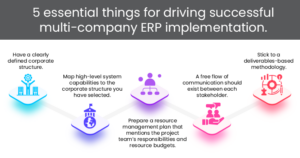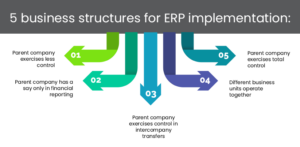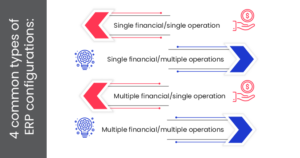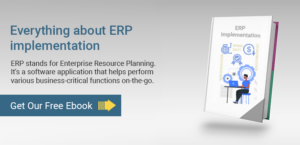Summary: Today, companies of all sizes, whether conglomerates or small and mid-sized companies, require ERP software to facilitate business processes and get their work done. Moreover, many organizations are looking to expand their domain by opening offices in different locations, requiring a multi-company ERP implementation that can simultaneously manage numerous operations. But the implementation process can be very challenging as it requires a continuous interplay between various forces, including business departments, core team members, vendors, external consultants, and end-users. As a result, many companies fail to implement the ERP system effectively and incur significant losses. On the other hand, those who succeed during this challenging phase open a sea of opportunities.
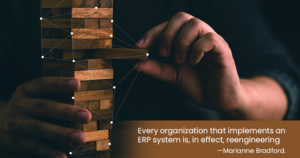
A multi-company ERP implementation is one of the most costly and risky projects that your company will ever undertake.
It can cost millions of dollars and can take many years.
Therefore it requires assistance from all departments. Employees need to devote about 50% of their time to re-engineer business processes, test systems, migrate data, and train others.
Another essential point is that the project must be finished within the stipulated time and budget that requires a system of checks and balances.
Let’s see 5 ways of how you can do multi-company ERP implementation:
1. Have a clearly defined corporate structure.
Different companies adhere to different corporate structures.
Some companies have multiple entities that exercise varying degrees of centralized or decentralized business functions.
Some organizations have all entities functioning in the same country and others have business operations spread across many countries.
Some enterprises apply varying costing methods to different business units but have standard master data files that facilitate intercompany buy-sell relationships.
At the outset, it’s essential to define the relationship between the parent company and the business units. This helps define ERP software requirements relating to master data, security, intercompany transactions, organizational structure, and administration.
You can select any one of the five business structures for ERP implementation:
a. Parent company exercises less control
In this structure, small business units in any part of the globe have total autonomy regarding systems, administration, and structures. The parent company exercises minimal or no control over how the business unit functions. As a result, the business unit can implement a separate ERP system if it desires to.
b. Parent company has a say only in financial reporting
In this case, the parent company gives total autonomy to business units except financial accounting and reporting. Business units are free to keep a separate ERP system for managing their daily operations. The parent company only manages the financial part of the business.
c. Parent company exercises control in intercompany transfers
Under this model, different business units are given autonomy for carrying out daily operations. However, the parent company manages the global supply chain by purchasing inventories, fulfilling requirements, and monitoring production schedules. It also fixes the incongruencies in ERP systems of different business units.
d. Different business units operate together
In this model, different business units can access each other’s data. Therefore there is a minor degree of centralization from the top. As a result, this model is suitable for business units with a certain degree of product-market overlap. In addition, it provides increased coordination and a better framework for applying common standards.
e. Parent company exercises total control
In this model, the parent company has complete control over the local business unit’s operations. It standardizes the business processes of the local unit and decides which ERP system it should use. This model shares a long history of massive failures and has an excellent track record for efficiencies and cost-benefit.
2. Map high-level system capabilities to the corporate structure you have selected.
Keep in mind that different corporate structures have been developed for diverse purposes. Some have strong capabilities that are better suited to satisfy the requirements of conglomerates, which have business units spread across multiple countries. Others are responsible for companies that follow simpler business structures.
After you have selected the desired corporate structure, it’s time to choose an appropriate ERP configuration.
Following are the four common types of ERP configurations with respect to the corporate structures we have discussed in the previous point.
a. Single financial/single operation.
Geographically centralized companies use single-site ERP configurations. Conglomerates with several business units spread across diverse regions might also use this configuration if:
i. They operate as a single entity within a single country. For example, if they don’t have to prepare different sets of financial records for taxation purposes.
ii. They follow the same set of processes within their distribution centers and plants.
iii. The headquarter manages the flow of goods and materials for each business unit.
b. Single financial/multiple operations.
Some conglomerates operate as a single financial entity that comprises multiple operational entities. For example, manufacturing, warehouse, sales & marketing, supply chain, and many more. The organization can adhere to varying business processes under this configuration.
c. Multiple financial/single operation.
An enterprise with a single manufacturing facility may have multiple sales offices spread across different countries. This ERP configuration allows the enterprise to account for diverse currencies, accounting regulations, taxations, and languages required for operating in multiple countries.
d. Multiple financial/multiple operations.
This ERP configuration is most appropriate for typical conglomerates that have multiple business units spread across many countries. For example, metal fabrication companies have resource procurement offices in China and have production facilities in the USA.
3. Prepare a resource management plan that mentions the project team’s responsibilities and resource budgets.
ERP implementation success depends on the agility of the team that consists of employees and external consultants.
McKinsey reports that only 20% of companies get more than half the estimated benefits from ERP systems.
Sadly, most challenges are created because of employee mismanagement and not due to technical issues. Thus, it would be best if you defined each team member’s responsibilities at the beginning.
Then, it’s important to focus on the budget. Keep in mind that labor costs account for the highest share in the budget.
It would help if you also had a separate section in the resource management plan that considers backfilling needs, internal personal commitments, external consulting support, and employee training costs.
Focusing on project management governance is critical to successful multi-company ERP implementation. Include stakeholders from all impacted areas like finance & accounting, production, sales & marketing, supply chain & planning, and many more.
Remember that these employees must devote at least 50% of their time to ERP implementation. So you may require an extra workforce to fill their positions.
An effective strategy is to create a team of backup personnel that takes care of low-value activities when the core team isn’t present. In addition, it would be best to prepare a contingency plan to take care of emergencies — for example, an employee quits the organization or is removed from the team.
The budget plan should also talk about new hiring, either full-time or part-time, to support the project.
Please take care of the following points while building the core team:
i. They should have excellent knowledge about the business processes of their particular department.
ii. They should have excellent knowledge about other business departments.
iii. They should have excellent communication skills to discuss the multi-company ERP implementation process with peers and give presentations to the team.
A skill matrix plays an integral role in developing a structured method to select the perfect candidates for the project, designing customized training schedules, and identifying the best external consulting support.
External consulting support is critical to the multi-company ERP implementation process because they are responsible for installing the software and training the staff. Therefore, search answers for the following questions before proceeding forward:
i. Do they have appropriate technical knowledge about the ERP system?
ii. Do they have the required domain knowledge?
iii. Do they have strong communication skills?
4. Stick to a deliverables-based methodology.
A deliverables-based methodology will allow you to track course progress efficiently. You can break down the project into measurable parts and identify what you have accomplished and what you haven’t. The best part is that if you drift away from the right track, you can find the earliest reasonable opportunity to course-correct with minimal impact.
You can create project milestones, such as planning, core-member training, data migration, process walkthroughs, and end-user training.
This methodology also sets deliverables for the core team members that they need to achieve within a set deadline. Reports are sent to respective managers every day, individual performances are monitored, and feedbacks are shared every day.
As a result, the project is finished within the set timeline, risks are eliminated or kept to the bare minimum, and there is a free flow of information between the core team and the team of external consultants.
5. A free flow of communication should exist between each stakeholder.
The multi-company ERP implementation process impacts the entire organization, from business departments and employees to business operations and external relations. Thus, it would be best if you had a free and fair communication ecosystem where critical information is shared quickly, doubts are resolved faster, and each stakeholder remains on the same page. The following points explain it in detail:
a. The project manager quickly reports the current project status to the senior management, including the CEO, CFO, CTO, etc. It makes it easy to:
i. Demand more money for project completion.
ii. Get critical issues resolves at the earliest.
iii. Clarify any change in project scope.
b. The external consultants can communicate the impact on jobs after the ERP implementation process is done.
c. The senior management can re-confirm their support for the multi-company ERP implementation project. They can also get real-time updates about the implementation process that helps brainstorm effective strategies to resolve critical issues.
d. The core team members can communicate with end-users and explain how the ERP implementation process will impact their relationships.
Conclusion
Successful multi-company ERP implementation requires collaboration between all business stakeholders, including the core team members, senior management, external consultants, and end-users.
A resource management plan is also essential as it helps keep things within budget and allows selecting the most appropriate people to pull the project.
Next, a delivery-based methodology ensures that each stakeholder is responsible for the assigned work, so that project milestones are accomplished within the set deadlines.
Finally, and most importantly, communication plays an integral role. It allows sharing crucial information with relevant stakeholders that speed up the implementation process and ensures that challenges are resolved quickly.
STAY UPDATED
Subscribe To Our Newsletter
At Sage Software Solutions (P) Ltd., we are home to world-class ERP software and CRM software that will solidify your business tech support fundamentals and enable you to build a customer-centric organization. You can also write to us at sales@sagesoftware.co.in.
Disclaimer: All the information, views, and opinions expressed in this blog are those of the authors and their respective web sources and in no way reflect the principles, views, or objectives of Sage Software Solutions (P) Ltd.

